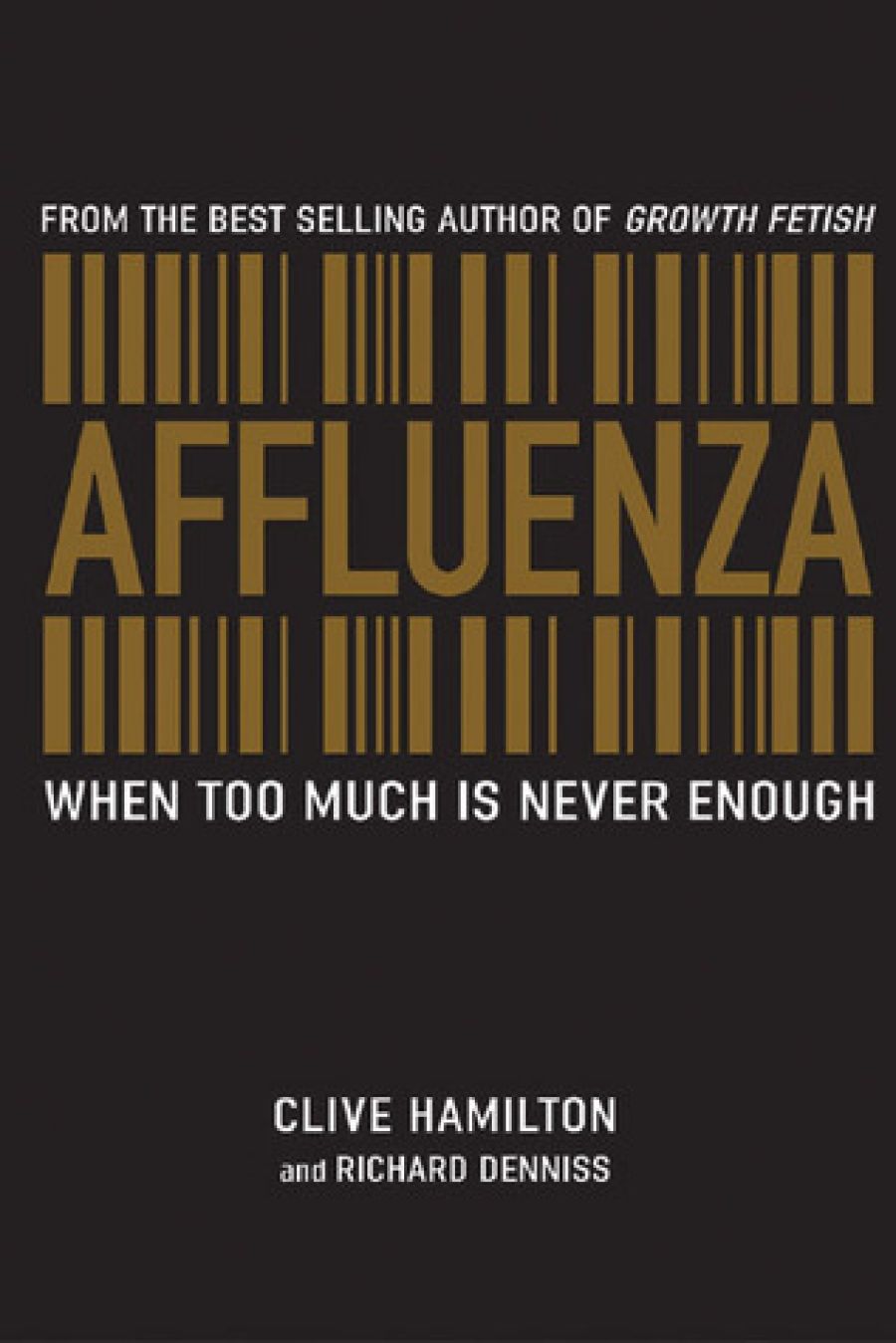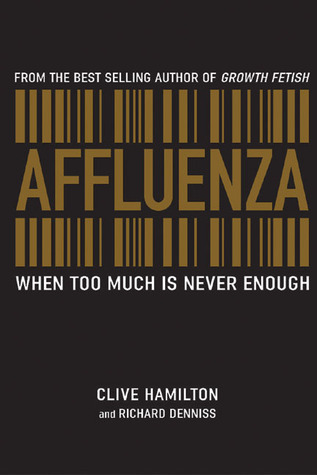
- Free Article: No
- Contents Category: Society
- Review Article: Yes
- Article Title: Keeping up with the Joneses
- Online Only: No
- Custom Highlight Text:
Since the early 1990s Australians have been infected with ‘affluenza’ – a virus of over-consumption that Clive Hamilton and Richard Denniss characterise as ‘the bloated, sluggish and unfulfilled feeling that results from efforts to keep up with the Joneses’, a growth fetish and an ‘epidemic of stress, overwork, waste and indebtedness caused by dogged pursuit of the Australian dream’.
- Book 1 Title: Affluenza
- Book 1 Subtitle: When too much is never enough
- Book 1 Biblio: Allen & Unwin, $24.95 pb, 224 pp
- Book 1 Cover Small (400 x 600):

- Book 1 Cover (800 x 1200):

Following on from the success of Growth Fetish (2004), which explored the disconnection between economic growth and personal well-being on a global scale, in his latest offering Clive Hamilton – this time with fellow Australia Institute Director Richard Denniss – turns closer to home, exploring the Australian obsession with materialism.
Affluenza: When Too Much Is Never Enough follows a long tradition of critiques that have developed more or less simultaneously alongside the growth of the consumer market. Thorstein Veblen, in his analysis of extravagant, wasteful and conspicuous consumption in The Theory of the Leisure Class (1899), and later intellectuals and social scientists such as John Kenneth Galbraith, Vance Packard and David Riesman, focused on American consumption habits as a key social problem. Packard, for example, in The Waste Makers (1960), blamed both producers and consumers for their ‘throwaway spirit’. While the term ‘consumerism’ had first been used to refer to the protection of the consumer interest, Packard applied it to mean a shift in economic thinking caused by market saturation. It was ‘forced consumption’ that made sure desire kept pace with production and expanded the wants of the people artificially. The process, according to Packard, would ‘make Americans in large numbers into voracious, wasteful, compulsive consumers’. However, it was not just the US that was subject to the climate of ‘growthmanship’; the entire Western world, including Australia, was not immune. Australian postwar critics debated the effect of modern capitalism that centred on the lack, or loss, of a distinctive Australian culture.
Affluenza shares much with these critiques, none the least painting modern Australian consumerism as a key social problem and Australian consumers as enthusiastic proponents of materialism. But unlike Packard, Hamilton and Denniss are not motivated by a Protestant ‘producer ethic’ that wishes to turn its back on mass production and mass consumption. Rather than rejecting consumption, they argue for a detachment from it. For them, it is not so much that consumption itself is bad; it is the attachment to stuff that feeds the epidemic of affluenza.
Divided into three parts, Affluenza explores the problems and manifestations of, and solutions to, the disease of affluenza, a term borrowed from de Graaf, Wann and Naylor’s 2001 book Affluenza: The All-Consuming Epidemic. Like the earlier work, Hamilton and Denniss argue that affluenza is akin to a virus that is spreading and multiplying. While ‘in the community there is a widespread belief that the values of the market – individualism, selfishness, materialism, competition – are driving out the more desirable values of trust, self-restraint, mutual respect and generosity’, and while most Australians agree that society is ‘too materialist and money driven’, it is hard to recognise that most of us have been afflicted with the virus because we are too caught up in the pursuit. The epidemic of over-consumption and money hunger is manifested in our debt-ridden and wasteful society, in an overworked, dissatisfied population, and in waste in the form of environmental degradation and rising consumer credit.
The book uses evocative examples to illustrate the manifestations of affluenza. Once a symbol of Australia’s egalitarianism, home-made from bricks and a hotplate, the barbecue has become a symbol of status that can be bought for thousands of dollars from specialist retailers. Despite smaller families, Australian houses are bigger than ever, and each year we spend more money on our pets than the Australian government does on foreign aid.
At the heart of the problem of affluenza is the misguided belief that material acquisition equals happiness and personal fulfilment. But, as the authors persuasively argue, happiness based on consumption can never be achieved, nor wants ever truly satisfied; there will always be a gap – an irreconcilable gap – between what you want and what you have.
While the consumer market is predicated on the illusion of choice and on the ability to buy or not to buy, the abundance of consumer products that fuels affluenza actually limits our choices beyond the market. ‘Materialism and its attendant self-absorption’ have a devastating effect on family life as parents work longer hours to buy products they don’t need; what children really need, the authors argue, is more time with their parents, not more things. Perhaps even more worryingly, the obsession with material acquisition erodes the more desirable values of a fairer society as people compete with each other in the pursuit of material acquisition.
One of the greatest strengths of this book is the attention given to the imagined hardship of the middle class and to the myth of the Aussie battler: ‘Australians today feel materially deprived, even though they are richer than ever before; a pervasive discontent is continually reinforced by consumer culture.’ While the authors stress that affluenza has been spreading since the early 1990s, its legacy can be traced to the postwar boom. It is during this period that the disease was incubating and the postwar consumer was its patient zero.
A more recent phenomenon, as the authors contend, is the political and public sympathy for those living beyond their means. Middle-class welfare in the form of tax cuts, baby bonuses and alarmist reportage of threatened interest rate rises on ‘battlers’ who have never been economically better off is evidence of affluenza spiralling out of control.
The book concludes convincingly, warning that the argument that it is futile to desire change because there is ‘no stopping the market’ as the ‘forces working against it, including human nature, will prevent it’ is anti-democratic. Despite a widespread, often unconscious, attachment to materialism, a large portion of the Australian population have deliberately chosen to ‘downshift’, favouring a more balanced and healthy lifestyle and personal fulfilment over long working hours, higher incomes and wasteful consumption. I doubt if this shift is enough to combat the spread of the virus.
The authors do more than highlight Australia’s unhealthy attachment to materialism and the urgent need to combat it. Hidden at the end of the book, beyond the endnotes and index, the authors offer ‘a political manifesto for well-being’ that outlines their programme for change, which will restore ‘the more desirable values of trust, self-restraint, mutual respect and generosity’ by expanding national well-being (not just the economy). In order to salvage our social democratic tradition, to combat poverty, to create a fairer and more satisfied population, we need to work ‘collectively [to] pursue a better society’ rather than declaring that there are ‘forces that will always overwhelm the preferences of the citizenry and that it is pointless for us to [try]’. I am unsure, however, if Affluenza can be the catalyst for change the authors desire, as they themselves note:
Most people seem unable to change course and introduce more balance in their lives, despite suspecting that a simpler life would probably be a happier one … They can see that affluenza is eating away at society, yet they are too fearful to change their behaviour in any meaningful way.
Australians have been more than enthusiastic proponents and supporters of consumerism. Despite a healthy consumer movement, political activism in the form of boycotts and mass consumer protest have never really characterised the Australian scene. In order to create a fairer, more just society, to fight poverty and to lessen our impact on the environment, we need widespread change and strong political commitment to combat the overwhelmingly virulent disease of affluenza.
I share much of the sentiment contained in this convincing, entertaining, accessible and timely book, yet I fear that it will only preach to existing converts. Rather than being polemic, I wonder if Affluenza will appeal to those suffering from the disease or will simply confirm the suspicions of those who have been cured or remain immune to it. That does not mean, of course, that we should give up trying to infect the population with an alternative virus.


Comments powered by CComment